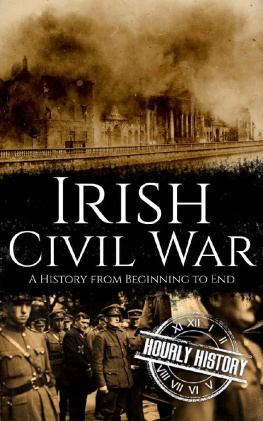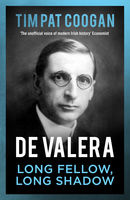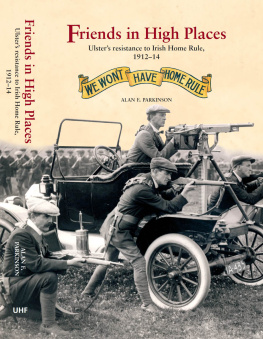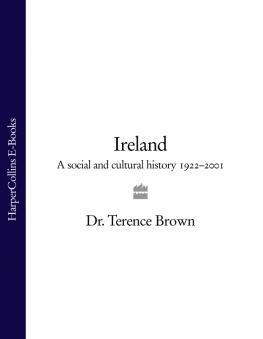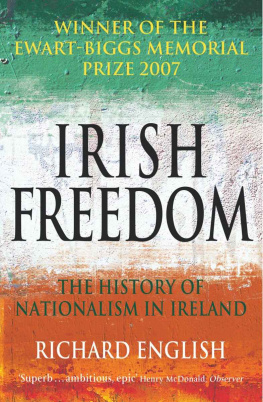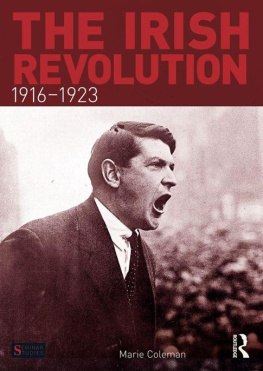A NATION
AND NOT A
RABBLE
DIARMAID FERRITER is Professor of Modern Irish History at University College, Dublin. He has written widely on Irish history, his books including The Transformation of Ireland 19002000, Occasions of Sin: Sex & Society in Modern Ireland and Ambiguous Republic: Ireland in the 1970s. In 2010 he presented the RTE TV series The Limits of Liberty and is a weekly columnist with the Irish Times.
ALSO BY DIARMAID FERRITER
The Transformation of Ireland 19002000
Judging Dev: A reassessment of the life and legacy of amon de Valera
Occasions of Sin: Sex and Society in Modern Ireland
Ambiguous Republic: Ireland in the 1970s
A NATION
AND NOT A
RABBLE
THE IRISH REVOLUTION 19131923
DIARMAID FERRITER

First published in Great Britain in 2015 by
PROFILE BOOKS LTD
3 Holford Yard
Bevin Way
London WC1X 9HD
www.profilebooks.com
Copyright Diarmaid Ferriter, 2015
The moral right of the author has been asserted.
All rights reserved. Without limiting the rights under copyright reserved above, no part of this publication may be reproduced, stored or introduced into a retrieval system, or transmitted, in any form or by any means (electronic, mechanical, photocopying, recording or otherwise), without the prior written permission of both the copyright owner and the publisher of this book.
A CIP catalogue record for this book is available from the British Library.
eISBN 978 1 84765 882 1
For Carmel Furlong
ACKNOWLEDGEMENTS
T aking the long view, work on this book began nearly twenty years ago when, with Paul Rouse and Catrona Crowe, I was involved in the research of a National Archives of Ireland (NAI) exhibition to mark the seventy-fifth anniversary of the foundation of the Irish Free State in 1922. That research introduced me to the Dil ireann files and other collections in the NAI and the documents led to much reflection then and in subsequent years on the nature and experience of the Irish revolution and its various layers. More research in the NAI as well as trawls through the extensive collections in the University College Dublin (UCD) archives, along with the UK National Archives in Kew, London, and the Public Record Office of Northern Ireland in Belfast, brought me to a deeper awareness of this period, an appreciation of its complexity and the reasons so many become absorbed in it. I am grateful to the staff of all these archives and the staff of the UCD library, which also houses valuable primary source material for the revolutionary decade this book assesses. My colleagues in the School of History and Archives at UCD deserve my deep gratitude for support and collegiality, especially Kate Breslin, as do friends for offering warmth and great company, including the Briggs family, Aisling Caden, Stephen Cullinane, Mark Duncan, Adrienne Egan, Liza Finnegan, Ronan and Karen Furlong, Ambo Kearney, Sen Kearns, James Kelly, Philip King, Cormac Kinsella, Pat Leahy, Anne, Tom, Catherine, Lucy, Rose and Kevin Maher, Peter Mooney, Deirdre Mulligan, Paul Murphy, Margaret Mac Curtain, Nuala OConnor, Greg Prendergast, Antoinette Prout, Yetti Redmond, Paul Rouse, Martin Walsh and David Whelan. Profile Books, yet again, have been generous and patient and provided unstinting support; thank you to the late Peter Carson as well as Andrew Franklin and Penny Daniel. I am particularly grateful to Trevor Horwood for his skilful copy-editing, and to Deirdre McMahon and Catrona Crowe for comments on earlier drafts of this book and for the conversations Catrona and I have had about this period and much else over many years of treasured friendship. As always, my greatest debts are to those closer to home; to my cherished parents, Nollaig and Vera, sublime siblings Cian, Trona and Muireann, and those we are lucky enough to have as long-standing, close and loyal friends, including the wonderful Carmel Furlong to whom this book is dedicated. I am also beyond fortunate to be surrounded by three beguiling, inspiring, intensely loveable and infuriating daughters, Enya, Rona and Saorla, and the adorable, formidable, insightful, sceptical, funny and generous Sheila Maher, whose support and love have helped this book, like the others, move from abstract to real.
INTRODUCTION
I n January 1922, George Gavan Duffy, a barrister and Sinn Fin TD who had served as an envoy for the Irish republican movement in Paris during the War of Independence, was appointed Minister for Foreign Affairs in the southern Irish provisional government, formed after the Anglo-Irish Treaty had been ratified to bring an end to that war. The Treaty offered, not the Irish Republic Sinn Fin had sought, but an Irish Free State as a self-governing dominion within the British Commonwealth, with continued subordination to the British Crown represented by an oath of allegiance to that crown. In April of that year, Gavan Duffy articulated a fear that the looming civil war had the potential to do lasting damage to Irelands reputation abroad and the fledging Free States dignity. He concluded there was urgency that those on both sides of the Treaty debate should ensure Ireland was seen as a nation and not a rabble.
That particular word rabble and other versions of it, frequently surfaced in assessments of the breakdown of the established order and the mayhem often apparent in the period of the Irish revolution from 1913 to 1923 that ultimately led to the creation of the state of Northern Ireland in 1920 and the Irish Free State in 1922, subsequently the Irish Republic. A horrified unionist, writing to her friend at the end of 1918, remarked: This is a very unpleasant country to live in now. We are going through so many changes. The democracy in Ireland are a very bad lot, they are so low and uneducated, only a rabble led by the priests.
The playwright and Abbey Theatre director Lady Augusta Gregory, when corresponding from her home in Galway with poet W. B. Yeats in the immediate aftermath of the 1916 Rising, commented: It is terrible to think of the executions and killings that are sure to come yet it must be so we had been at the mercy of a rabble for a long time, both here and in Dublin, with no apparent policy. And yet, as the executions of the Risings leaders were carried out, she changed her tone. Her mind was now filled with sorrow at the Dublin tragedy; the execution of John Mac-Bride, a long-standing republican activist and Boer War veteran, who was not involved in the planning of the Rising but who joined the fighting at its commencement, was the best event that could come to him, giving him dignity. The leaders, she concluded, were enthusiastic and I keep wondering whether we could not have brought them into the intellectual movement.
This concern with and admiration for dignity was partly what propelled Lady Gregory and other cultural nationalists to do what they did for Ireland, but it also left them feeling uncertain and ambiguous in their responses to the Irish revolution. Gregory had different views of what was happening at different stages. So did many. The idea of the rabble and the fear of it also reflected class divisions and the threat of class conflict, so obviously manifest in the Dublin Lockout of 1913, when employers refused to recognise the right of unskilled labourers to be members of the Irish Transport and General Workers Union (ITGWU): This is why the ITGWU was seen as such a threat. It organised outside of the craft unions, and brought together as a powerful industrial force the workers who were dismissed as rabble. With a home rule Ireland on the horizon, the 1913 Lockout was also a power struggle in relation to who would control a self-governing Ireland.
Next page


